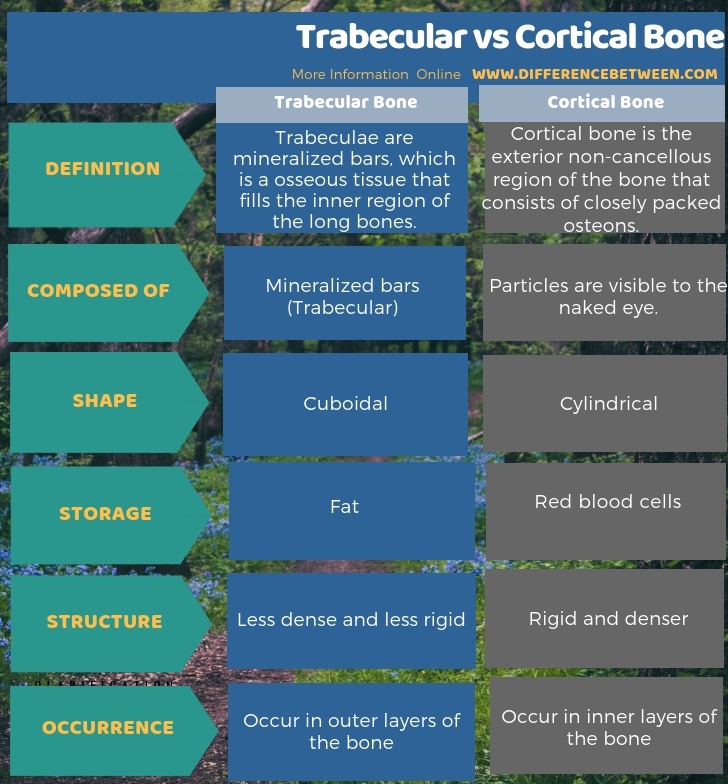Difference Between Trabecular and Cortical Bone
The key difference between trabecular and cortical bone is that the trabecular bone is the more porous inner regional layers of the body that produces red blood cells while the cortical bone is the rigid outer regional layers of the bone that stores fat.
Bone is a structural component that provides support for the movement, act as a reservoir for amino acids, phosphate, calcium, and bicarbonate, raising of hematopoietic stem cells, protection of interior organs, etc. Hence, bone plays a metabolic role in the body. It includes secretion of hormones that regulate energy metabolism. Moreover, trabecular and cortical compartments of bone play a major role in accomplishing these functions.
CONTENTS
1. Overview and Key Difference
2. What is Trabecular Bone
3. What is Cortical Bone
4. Similarities Between Trabecular and Cortical Bone
5. Side by Side Comparison – Trabecular vs Cortical Bone in Tabular Form
6. Summary
What is Trabecular Bone?
Trabecular bone is the osseous tissue present in the mid-region of the bones. They are less rigid and less dense than cortical bones. Spongy bone and cancellous bone are synonyms of trabecular bone. Trabecular bones are mineral bars that form a three-dimensional network in the matrix of the interior portion of long bones. Therefore, it facilitates the space for blood vessels and red bone marrow. Moreover, bone marrows in the trabecular bone produce red blood cells.

Figure 01: Trabecular Bone
The epiphyses are the enlarged ends of the long bones produced by trabecular bone. Hence, they are present in ribs, flat skull bones and shoulder bones. In trabecular bone, there is high metabolic activity. Furthermore, trabecular bones are cuboidal in shape. Osteoblasts convert trabecular bones to cortical bones.
What is Cortical Bone?
The cortical bone also is known as compact bone, is the most rigid outermost region of a bone. Hence, cortical bones are the strongest and densest bones in the body. They are made up of osteons. It is also referred to as compact bone. Cortical bones are rigid. However, for the maintenance of and repair of the bone, it consists with tiny passages for blood vessels and nerves. Moreover, the periosteum and endosteum cover the cortical bone from outside and inside respectively. The endosteum is a vascular connective tissue. Therefore, it lines the marrow cavity of long bones.

Figure 02: Cortical Bone
Osteocytes are present within the osseous tissue of the cortical bone. It surrounds by an extracellular matrix composed of calcium and phosphorous-rich hydroxyapatite. Collagen fibres present within the extracellular matrix provides limited flexibility to the cortical bone. They are cylindrical in shape. They provide structural support to the body and protect internal organs from physical stress.
What are the Similarities Between Trabecular and Cortical Bone?
- Trabecular and cortical bones are two types of bones present in animals.
- Both parts contain calcium.
- Also, both involve in providing movement to the body.
What is the Difference Between Trabecular and Cortical Bone?
Both trabecular and cortical bone are two parts of a long bone. Trabecular bone fills the inner region of the long bones while cortical bone makes the outer layer of the long bones. Therefore, this is the key difference between trabecular and cortical bone. Furthermore, another difference between trabecular and cortical bone is that the trabecular bone consists of mineralized bars while cortical bone consists of osteons. Moreover, the shape of these bones contributes to another difference between trabecular and cortical bone. That is, the trabecular bone is cuboidal in shape while the cortical bone is cylindrical in shape.
Below infographic presents more detail on the difference between trabecular and cortical bone.

Summary – Trabecular vs Cortical Bone
Bone is a structural component that provides support for the movement, act as a reservoir for amino acids, phosphate, calcium, and bicarbonate, raising of hematopoietic stem cells, protection of interior organs, etc. The key difference between trabecular and cortical bone is that the trabecular bone is the more porous inner regional layers of the bone while cortical bone is the rigid outer regional layer of the bone. Also, cortical bones are cylindrical in shape. Hence, they provide structural support to the body and protect internal organs from physical stress. On the other hand, trabecular bone consists of high metabolic activity. Therefore, they are cuboidal in shape. Thus, this summarizes the difference between trabecular and cortical bone.
Reference:
1. Study.com, Study.com. Available here
2. Ott, Susan M. “Cortical or Trabecular Bone: What’s the Difference?” American Journal of Nephrology, vol. 47, no. 6, 2018, pp. 373–375., doi:10.1159/000489672.
Image Courtesy:
1.”Bone cross-section”By Pbroks13 – Own work, (CC BY 3.0) via Commons Wikimedia
2.”Illu compact spongy bone”By SEER – U.S. National Cancer Institute’s Surveillance, Epidemiology and End Results (SEER) Program (Public Domain) via Commons Wikimedia
ncG1vNJzZmivp6x7pbXFn5yrnZ6YsqOx07CcnqZemLyue8OinZ%2Bdopq7pLGMm5ytr5Wau27A0ZqZnpuloa6zecCnm2abn6fBqq%2FApWSbp56afA%3D%3D